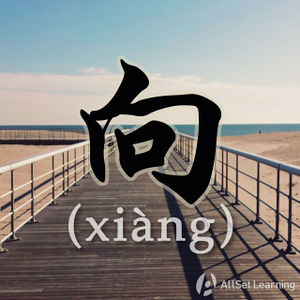Difference between revisions of "Expressing "towards" with "xiang""
m (Text replacement - ""," to ","") |
|||
| Line 3: | Line 3: | ||
向 (xiàng) is a preposition that means "towards," and is used often when expressing or referring to a certain point. | 向 (xiàng) is a preposition that means "towards," and is used often when expressing or referring to a certain point. | ||
| − | == | + | == Used as "Towards" == |
| − | When used as a preposition, "向" indicates an action that is performed towards a reference point, but doesn't have any actual motion towards that point | + | === Structure === |
| + | |||
| + | When used as a preposition, "向" indicates an action that is performed towards a reference point, but doesn't have any actual motion towards that point. | ||
<div class="jiegou"> | <div class="jiegou"> | ||
| − | + | 向 + [Direction Word] / [Person] + Verb | |
| − | 向 + | ||
| − | |||
</div> | </div> | ||
| Line 17: | Line 17: | ||
<div class="liju"> | <div class="liju"> | ||
| − | * | + | *<em>向</em> 东 走 。<span class="pinyin"><em>Xiàng</em> Dōng zǒu.</span><span class="trans">Walk towards east.</span> |
| − | * | + | *<em>向</em> 前 看 。<span class="pinyin"><em>Xiàng</em> qián kàn.</span><span class="trans">Look forward.</span> |
| − | * | + | *<em>向</em> 左 转 。<span class="pinyin"><em>Xiàng</em> zuǒ zhuǎn.</span><span class="trans">Turn left.</span> |
| − | * | + | *火车 已经 开 了 ,她 还在 <em>向</em> 我 招手。<span class="trans">The train already took off. She kept waving towards me.</span> |
| + | *不要 <em>向</em> 我 开枪 !<span class="trans"> .</span> | ||
| + | *老师 正 <em>向</em> 我们 走 来 。<span class="pinyin">Lǎoshī zhèng <em>xiàng</em> wǒmen zǒu lái.</span><span class="trans">The teacher is walking up towards us.</span> | ||
| + | *你 需要 <em>向</em> 他 道歉 。<span class="pinyin">Nǐ xūyào <em>xiàng</em> tā dàoqiàn.</span><span class="trans">You need to apologize to him.</span> | ||
| + | *这么 重要 的 事 你们 怎么 不 <em>向</em> 老板 报告 一下 ?<span class="trans">Why didn't you report such an important thing to the boss?</span> | ||
| + | *客户 不 了解 这个 情况 ,你 应该 <em>向</em> 他 解释 一下 。<span class="trans">The client doesn't know this situation. You should explain to him.</span> | ||
| + | *客户 不 了解 这个 情况 ,你 应该 <em>向</em> 他 解释 一下 。<span class="trans">The client doesn't know this situation. You should explain to him.</span> | ||
</div> | </div> | ||
| − | + | == Used as "From" == | |
| + | |||
| + | Whereas in English we would say "learn from someone," in Chinese this would be expressed as "learn toward someone," as in the following example (and famous propaganda slogan): | ||
<div class="liju"> | <div class="liju"> | ||
| + | *<em>向</em> 雷锋 同志 学习 !<span class="pinyin"><em>Xiàng</em> Léi Fēng tóngzhì xuéxí!</span><span class="trans">Learn from Comrade Lei Feng!</span> | ||
| + | </div> | ||
| − | * <em>向</em> | + | *我 不 喜欢 <em>向</em> 同事 借钱 !<span class="pinyin">Wǒ yào <em>xiàng</em> nǐ xuéxí!</span><span class="trans">I want to learn from you.</span> |
| + | *你 会 <em>向</em> 陌生人 求助 吗 ?<span class="trans"> .</span> | ||
| + | * <em>向</em> 。<span class="trans"> .</span> | ||
| + | ==See also== | ||
| − | |||
| − | |||
| − | |||
*[[Using "dui"]] | *[[Using "dui"]] | ||
*[[Expressing "with" with "gen"]] | *[[Expressing "with" with "gen"]] | ||
Revision as of 02:36, 14 September 2017
-
Level
-
Similar to
-
Used for
-
Keywords
向 (xiàng) is a preposition that means "towards," and is used often when expressing or referring to a certain point.
Contents
Used as "Towards"
Structure
When used as a preposition, "向" indicates an action that is performed towards a reference point, but doesn't have any actual motion towards that point.
向 + [Direction Word] / [Person] + Verb
Examples
- 向 东 走 。Walk towards east.
- 向 前 看 。Look forward.
- 向 左 转 。Turn left.
- 火车 已经 开 了 ,她 还在 向 我 招手。The train already took off. She kept waving towards me.
- 不要 向 我 开枪 ! .
- 老师 正 向 我们 走 来 。The teacher is walking up towards us.
- 你 需要 向 他 道歉 。You need to apologize to him.
- 这么 重要 的 事 你们 怎么 不 向 老板 报告 一下 ?Why didn't you report such an important thing to the boss?
- 客户 不 了解 这个 情况 ,你 应该 向 他 解释 一下 。The client doesn't know this situation. You should explain to him.
- 客户 不 了解 这个 情况 ,你 应该 向 他 解释 一下 。The client doesn't know this situation. You should explain to him.
Used as "From"
Whereas in English we would say "learn from someone," in Chinese this would be expressed as "learn toward someone," as in the following example (and famous propaganda slogan):
- 向 雷锋 同志 学习 !Learn from Comrade Lei Feng!
- 我 不 喜欢 向 同事 借钱 !I want to learn from you.
- 你 会 向 陌生人 求助 吗 ? .
- 向 。 .



